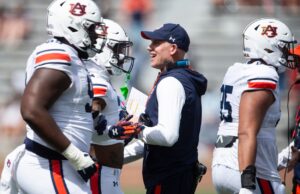WVU Pre-Spring Transfer Portal Update
As we move into Winter camp, portal entries typically begin to slow down, and for good reason. The deadline to enroll and still be eligible to participate in Spring camp has passed for many schools. For the rest, that deadline approaches rapidly. It is a good time, then, to revisit our review from a month ago of West Virginia’s relationship to the transfer market. As a result, we provide our WVU pre-Spring transfer portal update here.
Additions to 2022 Portal Class
The portal giveth, and the portal taketh away. Before assessing the negative side of the portal, we thought it fitting to talk about the additions in our WVU pre-Spring transfer portal update.
Cornerback
Most recently, WVU added Marcis Floyd from Murray State through the portal. Floyd continues the trend by the Mountaineers to add an FCS player to its secondary through the portal. Last season, they added Charles Woods, who had a few growing pains early, ended the season as the Mountaineers’ highest-graded defensive player with a grade of 82.3. This year, West Virginia will certainly hope to duplicate that success with standout FCS cornerback Floyd. He brings seven career interceptions to the Mountaineers and has two years of eligibility remaining.
Running Back
When fans think of recent Clemson running backs, Travis Etienne jumps to mind most immediately. But Lyn-J Dixon also ran very well for the Tigers as the second man out of the stable in 2019 and 2020. Over his career, he averages six-and-a-half yards per carry. Dixon was the first player the Mountaineers added through the portal this season, and he will be relied upon heavily absent any major surprise through Spring and Summer.
Tight End
Brian Polendey has not posted much to the stat line in his year at Miami or his two years at Colorado State. That said, the senior tight end has proven more than capable as a blocking tight end. Behind Mike O’Laughlin, the Mountaineers certainly have depth in the room, but they lack experience. As a result, Polendey may prove to be a welcome addition to the team, regardless what he adds to the stat sheet.
Defensive End
Zeiqui Lawton represents the “one who got away” from Head Coach Neal Brown and staff. As fans know, Brown made it an immediate priority to keep West Virginia prep prospects home for their college years. Brown earned a huge win in the Class of 2021 by keeping Wyatt Milum home. But he lost out on South Charleston product Lawton, who signed with Cincinnati instead. Persistence and patience, however, pay dividends from time to time. For the second straight year, Brown brought a highly-rated in-state prospect back home. Last year, they landed Doug Nester. This season, they grabbed defensive end Lawton from the portal.
Total Losses to the Transfer Portal
We know, we know. The average fan absolutely despises the transfer portal (at least when their team losses players). In most instances, we do, too. The idea of it makes sense. Players facing extraordinary circumstances (abrupt coaching changes, family troubles, grade issues, etc.) should have an easy avenue to transfer. Unfortunately, it has been been aptly compared to free agency for college football, throwing the game into a bit of turmoil as players and coaches adjust. That said, it is what it is at this point. It exists, so we continue to follow the trends.
As a reminder, we divide transfer portal classes in the same way 247Sports does. Players who enter the portal after August 1 of 2021 count towards the transfer class of 2022. Players who enter before then, count towards the transfer class of 2021, and so on down the line. We are now halfway into the fourth full transfer portal class. Some teams fare better than others. For West Virginia, the results represent a mixed bag.
On the one hand, the Mountaineers have brought in immediate impact performers from the portal. On the other, they have lost plenty themselves. For the Class of 2022, WVU, to date, added 16 players to the portal. That number will likely remain flat until after Spring ball when the next round of portal entrants decide to take their talents elsewhere for the 2022 season.
Since its inception, West Virginia lost 59 players to the portal. Even though we do not measure portal entrants on a calendar-year basis (because it does not make logical sense), because of some assertions made among West Virginia fans, it is worthwhile to note that the Mountaineers lost 32 players to the portal since January 1, 2021.
How Those Numbers Compare Nationally
One thing we try to be clear about when discussing the portal is this unassailable fact. Every team suffers losses to the transfer portal. Indeed, looking solely at the Power Five (plus Notre Dame and BYU) ranks, over 3,000 players entered the transfer portal since its inception.
In its first three years (2019 through 2021), over 2,200 entered for an average of 733. This means that over the past three seasons, each school has, on average, lost 11.2 players to the portal per year (or 13% of its scholarship cap of 85). For the Class of 2022, the total to date is 827, not including, of course, the Spring transfer crop. That means the 2022 average has grown to 12.5 outbound transfers per school. (And that does not even include G5 schools, several of whom fare even worse).
In the first three years of the portal, West Virginia fared a bit worse than average, losing about 14 players per season compared to the national average of 11. That said, it was nowhere near the worst. Indeed, WVU finished outside of the “top” 10. The worst teams during that span, Nebraska and Tennessee, lost 57 (14 more than West Virginia).
This year, West Virginia again fares worse than average, losing 16 versus the national average of 12.5. Again, however, the Mountaineers fall outside of the “top” 10. In total, 15 teams have lost more players that WVU to the portal class of 2022.
Some fans have designated January 1, 2021, as the arbitrary date by which to measure West Virginia’s portal losses against the rest of the country. Even by that measure, five teams have lost as many as or more than the Mountaineers to the portal. Again, there is no measure by which WVU represents the worst team in the country via the transfer portal.
Where the Losses Come From
Of the 59 total players West Virginia has lost to the portal since its inception (a number that still isn’t even close to the highest number), eight of them were walk-on transfers. Of the walk-on transfers, half of them committed under Dana Holgorsen, and the other half committed under Brown.
That leaves 51 scholarship transfers. Just 17 (or 33%) of those signed to the program under Neal Brown. The remaining two-thirds represent Holgorsen-era recruits. In many ways, Brown did a better-than-average job retaining players from a prior coaching staff, as most of these transfers waited a year or more to transfer after Brown took over the head coaching position in Morgantown.
Of those whose transfer destinations have been revealed, 21.5% of those players (11 total) transferred to Power Five Plus destinations. Only one of those has yet to make a substantial impact on his new team (Josh Sills). This hovers right around the national average of 22% of Power Five Plus transfers landing at another Power Five Plus institution.
What the Trend Looks Like
Unfortunately, the nationwide trend towards the portal continues to grow. We would expect each school to lose an average of four or more players after Spring camp. If that proves true, then the Class of 2022 will see an average of 5.3 players more players per class enter the portal than in 2021. This would represent an increase above 45%.
That said, the trend, both at West Virginia and elsewhere, remains telling. The vast majority (nearly 80%) of these portal entrants end up stepping down a level. Even fewer make a substantial impact at their next destination. Perhaps the next few years of data telling this story may encourage young student athletes to reconsider their approach. Often, the grass is not greener on the other side.






